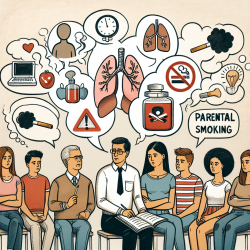Introduction
In the realm of speech-language pathology, particularly when working with children, understanding the broader determinants of health is crucial. A recent systematic review titled "Community interventions with women’s groups to improve women’s and children’s health in India: a mixed-methods systematic review of effects, enablers and barriers" provides valuable insights into how community-based interventions can significantly enhance health outcomes for children. This blog will explore the findings of this review and discuss how practitioners can integrate these insights into their practice.
Key Findings from the Research
The review synthesized evidence from 99 studies, including randomized controlled trials, quasi-experimental studies, and non-experimental studies. The findings suggest that interventions involving women's groups can lead to improvements in perinatal practices, neonatal survival, immunization rates, and dietary diversity among women and children. The most effective interventions were those that went beyond mere information dissemination and actively engaged communities in capability building.
Enablers and Barriers
The research identified several enablers and barriers to successful interventions:
- Enablers: Inclusion of vulnerable community members, relevant health outcomes, and sufficient intervention intensity.
- Barriers: Limited time or focus on health, outcomes not relevant to group members, and health system constraints.
Understanding these factors is crucial for practitioners aiming to implement similar interventions in their practice.
Implications for Practitioners
For practitioners in speech-language pathology, particularly those working with children, the findings underscore the importance of community engagement. Here are some actionable steps practitioners can take:
- Engage with Community Groups: Collaborate with existing women's groups to disseminate health information and promote practices that enhance child health outcomes.
- Focus on Capability Building: Design interventions that not only provide information but also empower communities to take action on health issues.
- Address Barriers: Work with local health systems to overcome constraints and ensure interventions are relevant to the community's needs.
Encouraging Further Research
While the review provides a comprehensive overview, there is always room for further research. Practitioners are encouraged to explore additional studies that focus on different contexts or populations to broaden their understanding of effective interventions.
Conclusion
Community interventions with women's groups hold significant potential for improving child health outcomes. By understanding and implementing the findings of this research, practitioners can enhance their practice and contribute to better health outcomes for children. For those interested in delving deeper into the research, the original paper provides a wealth of information and can be accessed here.










